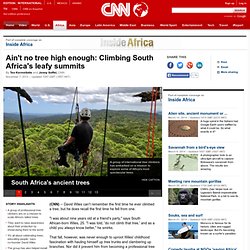

Seedsave.org. Plants For A Future : 7000 Edible, Medicinal & Useful Plants. Top 10 Most Dangerous Plants in the World. 1. Most likely to eat a rat Giant Pitcher Plant: Nepenthes attenboroughii Discovered more than 5000 feet above sea level on Mount Victoria in the Philippines, the giant, carnivorous pitcher plant secretes a nectar-like substance to lure unsuspecting prey into a pool of enzymes and acid.
A series of sticky, downward ribs makes it nearly impossible for trapped prey to escape. The plant's 30-centimeter diameter is large enough to trap unlucky rodents, but insects are its most common meal. 2. Castor Bean Plant: Ricinus communis Castor-bean plants can be purchased at just about any garden center, despite containing the deadly poison ricin. 3. Western Water Hemlock: Cicuta douglasii Deemed the most "violently toxic plant that grows in North America" by the USDA, the water hemlock contains the toxin cicutoxin, which wreaks havoc on the central nervous system, causing grand mal seizures--which include loss of consciousness and violent muscle contractions--and eventually death, if ingested. 4. 5.
Loofah Plant Seeds Absorb Organic Pollutants and Heavy Metals from Wastewater. Seeds and oils from the plant that produces the loofah sponge could help purify wastewater and prevent the spread of waterborne diseases in the developing world, according to a scientist speaking today at the 17th Annual Green Chemistry & Engineering Conference in Bethesda, Md.

The low-cost, biodegradable seeds and substances made from oils of these seeds are particularly effective at absorbing heavy metals and other potentially harmful organic compounds from polluted water, he said. Adewale Adewuyi, Ph.D., a lecturer at Redeemer’s University in Mowe, Nigeria, notes that rain water, rivers and streams are the most common direct sources of drinking water in many developing countries.
Often, this water is polluted with substances from factories and agricultural runoff, which can harm both people and animals. Absorbents, such as activated carbon, can help absorb these pollutants from water. However, they work slowly, are only effective in a limited pH range and are expensive. Toxic Detergents vs Soap Nuts A Laundry Soap You Can Eat - Page 2. Ain't no tree high enough: Climbing Africa's leafy summits. A group of international tree climbers has embarked on a mission to explore some of Africa's most spectacular trees.

Launched by David Wiles (pictured), the "Explore: The Ancient Trees of Africa" project is aiming to help highlight the need to preserve South Africa's spectacular trees. Last January, the group climbed Africa's biggest baobab in South Africa's Limpopo province. "Just watching the sun going down from the top of that tree was amazing," remembers Wiles. Genetic resources of agroforestry trees. Shock findings in new GMO study: Rats fed lifetime of GM corn grow horrifying tumors, 70% of females die early. Dutch Study Says Wi-Fi Makes Trees Sick. A recent study by Dutch scientists found that Wi-Fi radiation could be responsible for sickness in urban-populated trees.
Image: baltimoresun What would life be like without Wi-Fi, bringer of high speed internet access? Probably pretty inconvenient considering that millions of computer users around the world use it at home, at work and other public places to get online. Having access to wireless networks makes our lives easier, but according to a Dutch study from Wageningen University, this access may be compromising the health of trees. The study began five years ago in the city of Alphen aan den Rijn. According to an article from PC World : “The study exposed 20 ash trees to various radiation sources for a period of three months. Image: p2pnet Sounds pretty scary, doesn’t it? What do you think? Digg.
Punk Rock Permaculture E-zine. Seeds at Risk in AgroBusiness.